The republic of Indonesia consists of more than 17.000 islands, and is located in the golden triangle when it comes to biodiversity. To say that this widespread country is a heaven for divers is an understatement. At this magical place, which is stretching 5.120 km from east to west, and 1.760 km from north to south, you can find pretty much everything you want when it comes to encounters underwater.
If you stick to the central part of Indonesia, between the islands of Sumbawa and Flores, you find Komodo National Park. Established in 1980 it had mainly one purpose: To protect the largest living reptile on earth, the Komodo dragon (Varanus komodoensis) and the habitat where the dragon lives. Luckily, the purpose has expanded, and now the Komodo National Park is protecting the biodiversity in the whole area, both above and underwater.
Spread over more than 1.800 km2, the park is hosting everything from vibrant coral reef to sleek seagrass beds, from seamounts to mangroves. Within the park you find more than 1.000 species of fish and 260 species of reef building corals – so of course the chances of having unique meetings are large.
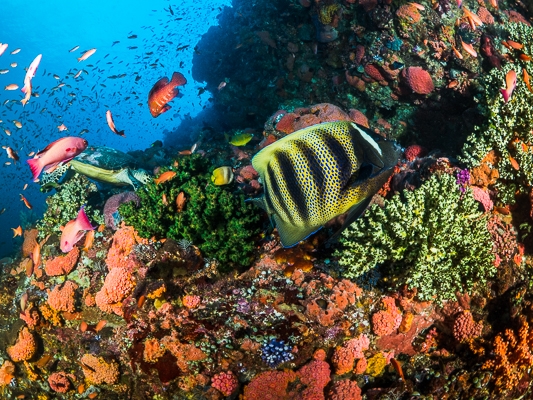
Ann Karin Matberg • OM-D E-M1 Mark II • M.ZUIKO DIGITAL ED 8 mm 1:1.8 Fisheye PRO
• PT-EP14 • PPO-EP02 • 2 x UFL-3
The best way to explore the national park and the area around it is without doubt on a liveaboard boat, and there are multiple choices of companies to pick from. Earlier this year, I had the pleasure to spend ten days on “Mermaid I” cruising from Bali all the way to the southern part of Komodo National Park – and back again. This was not my first time diving in this area, and it will for sure not be the last one.
Most of the species you can meet here are common to find all over the Pacific or Indian Ocean but some sites just give you that little extra. The richness of colors and the amount of life on some of the sites just blows my mind! Deciding where to look, where to position the camera, how to frame the picture to make justice to the surrounding can be very difficult since there is so much to see, so much to take pictures of!
One favorite of mine is Batu Bolong, a pinnacle sticking up just above the surface. The tiny part above the water is not much bigger than our boat, but the rapidly sloping part underwater is getting bigger and wider the further down you get. As this is in the middle of the ocean the currents are ripping. It looks like a fiercely flowing river, and to imagine myself getting in the water there seemed absolutely insane. But the guide promised that as long as we stay within the “shade” of the pinnacle and do not explore the outer perimeters, we will be perfectly safe. Believe me: Even thinking of testing the borders is out of question! There are enough stories about divers doing that and ending up being swept away tens of kilometers in no time.
Since I have been diving here before I knew what to expect, and I kept telling my fellow passengers: If there is one dive you should do on this trip, it is this one!
Because of the currents running on both sides the amount of nutrition in the water is extremely high. And the sight that is meeting you underwater is just incredible! There is more fish per square meter here than in a fish tank in a pet store, and the colors of the corals are the most vibrant I have ever seen underwater. Sharks or turtles, napoleons or fusiliers. Big eyes or jack fish. Pick your favorite, and you will most likely find it here.
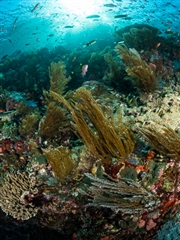
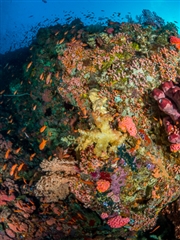
Ann Karin Matberg • OM-D E-M1 Mark II • M.ZUIKO DIGITAL ED 8 mm 1:1.8 Fisheye PRO
• PT-EP14 • PPO-EP02 • 2 x UFL-3
Even though the area for safe diving is quite small, you will not be bored diving here, I promise you!
Start from the bottom and zigzag your way upwards within the safe zone and you will for sure enjoy one of your most stunning dives ever.
On four islands within the national park you can meet the animal that caused the creation of the park: The Komodo dragon. This giant lizard can grow up to 3 meters and weight up to 70 kilos and can only be found here. It is a carnivore, mainly living from carrion, but also hunting for live pray. As a visitor we were always protected by rangers equipped with long wooden sticks since the dragons may attack humans. On a few encounters divers have been swept away by the fierce currents within the park, transported far away and rescuing themselves on a beach feeling safe, only to realize they have stranded on one of the islands inhabited by the hungry dragons. Talk about getting out of the frying pan and into the fire...
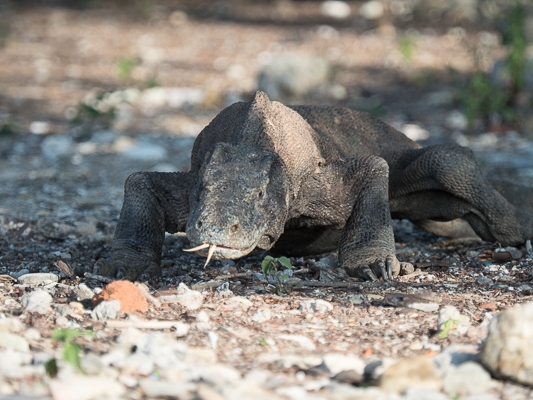
Ann Karin Matberg • OM-D E-M1 • M.ZUIKO DIGITAL ED 40-150 mm 1:2.8 PRO
Luckily Komodo offers other types of giants as well, which are also more suitable as diving companions than the dragons. Crystal and Castle Rock are both famous dive sites that have a lot in common. Many divers go there in hope of seeing a shark or two and the chances of encounters with large fish are great on both sides. Entering the water at Castle Rock we had the unusual pleasure of arriving when there was absolutely no current. Being prepared for strong currents and having my hands free for hooking up, I had not taken my dome cover off, or gotten my camera ready for shooting, and rarely have I regretted that more. We landed in a huge school of surgeonfish where large trevallies hunt and amongst them three white tip sharks shot as arrows trying to catch their dinner! Realizing it will take too long to prepare the camera I simply let the camera hang, and enjoyed the unique moment watching the flow of fish before the sharks passed to other hunting grounds. But the surgeonfish stayed, and as I was lying floating in mid water they suddenly surround me on all sides. I had beautiful yellow-masked fish literally all around me – over, under, in front, behind and on both sides! Hanging there in this massive school was so overwhelming that I forgot that I could have turned on the camera and taken a selfie that would show to what extent I was in a middle of a fish soup.
After a short time the current picked up, and we headed for the drop off to watch the sharks patrol back and forth, totally unaffected by the current. Eagle rays are also a common sight on these dives, and when you add healthy, vibrant soft and hard corals this is absolutely worth a dive.
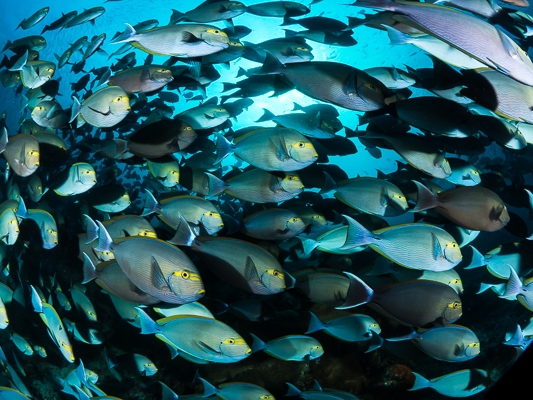
Ann Karin Matberg • OM-D E-M1 Mark II • M.ZUIKO DIGITAL ED 8 mm 1:1.8 Fisheye PRO
• PT-EP14 • PPO-EP02 • 2 x UFL-3
But there is one giant that brings the thrill out of almost every diver: The manta ray. Growing to more than 5 meters wide the Manta alfredi is an impressive sight. Since this ray is mostly resident this is exactly what you long to see when visiting Manta alley. Cleaning stations that the mantas frequently visits to get rid of parasites is probably the best place to get really close to these gentle animals. I never stop being amazed that they can be so huge, and still not make a single sound while “flying” past us. Having mantas coming into view from all directions makes it hard to decide where to look and what manta to follow. No matter how many you see, you should always respect the animals, do not disturb them while they clean and listen to your guides. The smiles on everyone’s faces were almost as wide as the mantas when we reached the surface, although some of us had blue lips since temperature dropped from comfortable 28 degrees in the northern part to 22 here in the south ...
Luckily none of us had to dive with the dragons, but seeing these rare animals is a once in a lifetime experience for most people. Let us hope the act of human can still let this, and many other endangered species, breed and thrive while we can come and visit, and leave without leaving anything but bubbles and hundreds of pictures on the memory card.
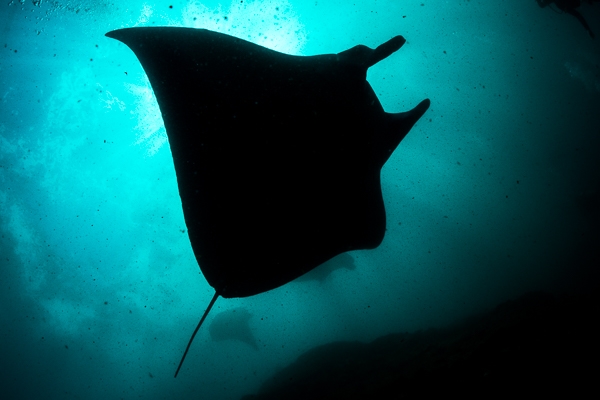
Ann Karin Matberg • OM-D E-M1 Mark II • M.ZUIKO DIGITAL ED 8 mm 1:1.8 Fisheye PRO
• PT-EP14 • PPO-EP02 • 2 x UFL-3
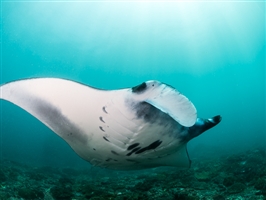
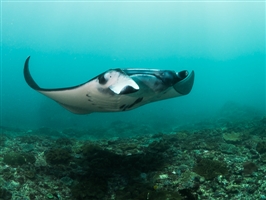
Comments